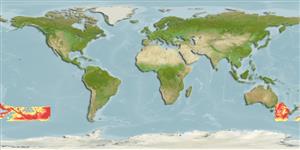Teleostei (teleosts) >
Anguilliformes (Eels and morays) >
Synaphobranchidae (Cutthroat eels) > Synaphobranchinae
Etymology: Histiobranchus: Greek, istion, istos = sail + Greek, brangchia = gill (Ref. 45335).
Environment: milieu / climate zone / depth range / distribution range
Ecology
Marine; benthopelagic; depth range 3493 - 4974 m (Ref. 31334). Deep-water; 33°S - 55°S
Southwest Pacific: Tasman Sea and off southeastern New Zealand.
Size / Weight / Age
Maturity: Lm ? range ? - ? cm
Max length : 69.0 cm TL male/unsexed; (Ref. 26895)
Short description
Identification keys | Morphology | Morphometrics
Dorsal soft rays (total): 347; Anal soft rays: 214 - 251; Vertebrae: 162 - 163. Upper limit of dorsal fin rays is 408; dorsal fin rays before anus 136-166; precaudal vertebrae 86-88 (Ref. 31334). Pectorals small.
Life cycle and mating behavior
Maturities | Reproduction | Spawnings | Egg(s) | Fecundities | Larvae
Karmovskaya, E.S. and N.R. Merrett, 1998. Taxonomy of the deep-sea eel genus, Histiobranchus (Synaphobranchidae, Anguilliformes), with notes on the ecology of H. bathybius in the eastern North Atlantic. J. Fish Biol. 53(5):1015-1037. (Ref. 31334)
IUCN Red List Status (Ref. 130435)
Threat to humans
Harmless
Human uses
Tools
Special reports
Download XML
Internet sources
Estimates based on models
Preferred temperature (Ref.
123201): 0.9 - 1.5, mean 1.3 °C (based on 469 cells).
Phylogenetic diversity index (Ref.
82804): PD
50 = 0.6250 [Uniqueness, from 0.5 = low to 2.0 = high].
Bayesian length-weight: a=0.00071 (0.00031 - 0.00164), b=3.12 (2.92 - 3.32), in cm total length, based on LWR estimates for this (Sub)family-body shape (Ref.
93245).
Trophic level (Ref.
69278): 4.2 ±0.5 se; based on size and trophs of closest relatives
Fishing Vulnerability (Ref.
59153): Moderate to high vulnerability (48 of 100).
